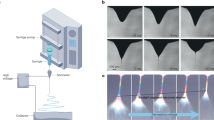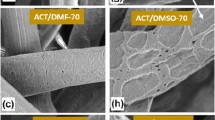Abstract
Electrospinning is a process that generates nanofibres. Temperature and humidity affect this process. In this article the influence of humidity and temperature on the formation and the properties of nanofibres are studied using cellulose acetate (CA) and poly(vinylpyrrolidone) (PVP) as target materials. The experiments indicate that two major parameters are dependent of temperature and have their influence on the average fibre diameter. A first parameter is the solvent evaporation rate that increases with increasing temperature. The second parameter is the viscosity of the polymer solution that decreases with increasing temperature. The trend in variation of the average nanofibre diameter as a function of humidity is different for CA and PVP, which can be explained by variations in chemical and molecular interaction and its influence on the solvent evaporation rate. As the humidity increases, the average fibre diameter of the CA nanofibres increases, whilst for PVP the average diameter decreases. The average diameter of nanofibres made by electrospinning change significantly through variation of temperature and humidity.




Similar content being viewed by others
References
Formhals A (1934) Process and apparatus for preparing artificial threads. US Patent 1,975,504
Miqin Z (2007) Alginate-based nanofibers and related scaffolds. US Patent WO2007112446
De Vrieze S et al (2007) J Mater Sci 42:8029. doi:https://doi.org/10.1007/s10853-006-1485-6
Frenot A et al (2007) J Appl Polym Sci 103:1473
Gibson PW et al (1999) AICHE J 45:190
Aussawasathien D, Dong JH, Dai L (2005) Synth Met 154:37. doi:https://doi.org/10.1016/j.synthmet.2005.07.018
Jin WJ et al (2007) Synth Met 157:454
Yang Y et al (2006) IEEE Trans Dielectr Electr Insul 13:580
Tripatanasuwan S, Zhong Z, Reneker D (2007) Polymer (Guildf) 48:5742. doi:https://doi.org/10.1016/j.polymer.2007.07.045
Givens SR et al (2007) Macromolecules 40:608
Wang C et al (2007) Macromolecules 40:7973
Thompson CJ et al (2007) Polymer 48:6913
Yang QB et al (2004) J Polym Sci Part B-Polym Phys 42:3721
Tungprapa S et al (2007) Cellulose 14:563
Lin K et al (2007) Polymer 48:6384
Greenspan L (1977) J Res Natl Bur Stand 81A:89
Casper L et al (2004) Macromolecules 37:573
Dalton J (1802) Mem Lit Philos Soc 5:535
CRC Handbook of Chemistry and Physics, 44th edn, pp 2582–2584
Author information
Authors and Affiliations
Corresponding author
Rights and permissions
About this article
Cite this article
De Vrieze, S., Van Camp, T., Nelvig, A. et al. The effect of temperature and humidity on electrospinning. J Mater Sci 44, 1357–1362 (2009). https://doi.org/10.1007/s10853-008-3010-6
Received:
Accepted:
Published:
Issue Date:
DOI: https://doi.org/10.1007/s10853-008-3010-6




